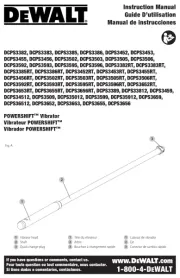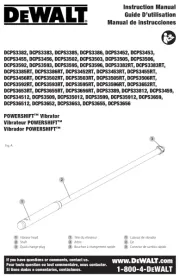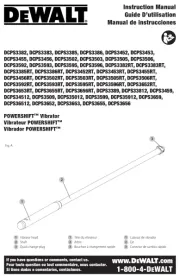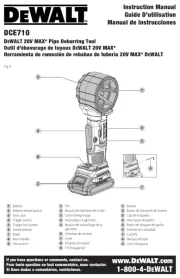DeWalt DS302 Handleiding
DeWalt
Niet gecategoriseerd
DS302
Bekijk gratis de handleiding van DeWalt DS302 (8 pagina’s), behorend tot de categorie Niet gecategoriseerd. Deze gids werd als nuttig beoordeeld door 247 mensen en kreeg gemiddeld 5.0 sterren uit 124 reviews. Heb je een vraag over DeWalt DS302 of wil je andere gebruikers van dit product iets vragen? Stel een vraag
Pagina 1/8

DS300 Jobsite Security Cable Lock
DS302, DS306, DS312 and DS324
Replacement Cables
WARNING: Read and understand all instructions and
warnings for this product. In addition, read and follow all
instructions and warnings provided with the DS100 Jobsite Security
Portable Alarm System.
CAUTION: DANGER OF EXPLOSION, INJURY, OR FIRE.
Carefully follow all instructions and warnings on the battery label and
package.
• Never use a damaged or worn out battery.
• Discharged batteries should be replaced only with type CR-123 3.0
Volt Lithium batteries.
• Do not use re-chargeable batteries or attempt to charge batteries.
• Carefully remove the old, discharged battery.
• Do not attempt to open.
• Do not peel the label from the battery.
• Never dispose of a battery in a fire.
• Dispose of used batteries in accordance with local regulations.
• Recycle batteries.
• Always insert batteries correctly with regard to polarity (+ and -)
marked on the battery and the equipment.
• When installing the battery, do not use excessive force. If the bat-
tery does not fit, check to make sure that it matches the polarity
markings.
• Never expose the battery terminals to any other metal object. This
can short circuit the battery.
• Avoid exposure to temperature extremes.
• When not in use, store the battery in a cool, dark, dry place.
• Keep batteries out of reach of children.
FCC REGULATORY STATEMENT (FCC: HCQ3B6ETUMXM)
• This device complies with Part 15 of the FCC rules. Operation is
subject to the following two conditions: (1) This device may not
cause harmful interference, and (2) the device must accept any
interference received, including interference that may cause unde-
sired operation.
INDUSTRY CANADA (IC: 2309A-ETUMXM)
•NOTICE: This equipment meets the applicable Industry Canada
Terminal Equipment Technical Specifications. This is confirmed
by the registration number. The abbreviation, IC, before the reg-
istration number signifies that registration was performed based
on a Declaration of Conformity indicating that Industry Canada
technical specifications were met. It does not imply that Industry
Canada approved the equipment.
Important
• The Cable Lock needs to be removed before operating the
attached equipment.
• The Cable Lock uses a cable with a stainless steel braid. If the
exterior coating is cut, torn or abraded, the exposed metal could
short out equipment. Immediately replace the cable. Replacement
cables [2' (.61m), 6' (1.83m), 12' (3.66m) and 24' (7.32m) lengths]
are available as an additional accessory.
• To avoid constant unsecured alarms, be sure that the Cable Lock
is closed while it is not being used.
• Inspect the gasket whenever the housing is opened and replace if
worn or damaged. Be sure the gasket is in the proper position
before closing the housing.
• This product is designed for indoor/outdoor use.
Components
A. Gasket F. Tamper
B. Inner housing G. Battery
C. Outer housing H. Screws
D. Cable lock lever I. Replaceable cable
E. Reset button
Product Function
The DS300 Jobsite Security Cable Lock is a 12' (3.66m) cable impreg-
nated with a heavy duty urethane jacket over stainless steel braiding
which provides strength, durability and flexibility. As the cable ends are
disconnected, the system will be notified of an unsecured device.
Once activated, this device will work exclusively with the assigned
DS100 Jobsite Security Portable Alarm System.
1. The DS300 contains a locking mechanism with a location for a
standard padlock (not included) to provide additional security. The
addition of a padlock is recommended.
2. The DS300 features a tamper that notifies the system when the
cover has been opened.
3. The DS300 features 900 MHz spread spectrum communication
with the Base Unit allowing for a range of up to 2000' (610m).
NOTE: Metal objects blocking radio frequency (RF) transmission can
affect the range of the sensor.
Prevention of False Alarms
The majority of alarms that occur are false. These situations happen
every day due to user error, incorrect installation or improper mainte-
nance of the system. False alarms will limit the responsiveness to the
SITELOCK LLC, 626 Hanover Pike, Hampstead, MD 21074 (MAR05) Form No. 626136-01 DS300 Copyright © 2004, 2005 DEWALT
CAUTION: POTENTIAL EQUIPMENT
MALFUNCTION OR FAILURE. Do not
touch the electronic components inside
the device, except the reset button and
battery.
CAUTION: POTENTIAL EQUIPMENT
MALFUNCTION OR FAILURE. If exterior
coating is damaged and the metal is
exposed, the secured equipment could
short out.
JD
J
H
D
EF
D
M
I
C
A
B
G
FIG. 1
KLFIG. 3
FIG. 2

2
system, and become a general inconvenience. As the number of
false alarms increases, authorities have become less apt to respond
to alarm systems due to this problem. Many of these situations can be
avoided by following some very simple practices.
• Ensure all users are properly trained on the operation of the
system.
• Always turn off the system with the Key Chain Remote Control
before entering protected area.
• Lock all protected doors, windows or any other asset attached to
a sensor.
• Check that motion detectors are not obstructed. Do not allow
sources of heat or sound in range of the motion or vibration
sensors.
• Check that premises are cleared and assets secured before setting
the system.
• Turn off all noise sources – radios, compressors, generators,
heavy equipment, etc.
• Know how to cancel an alarm or turn off the system before
activating.
• If a false alarm is tripped notify customer service immediately.
• Test the system on a monthly basis to ensure proper functioning
• Check cellular signal, power supply, and that sensors are secured
on a daily basis.
Recommended Locations
• Secure product off the ground [above 3 feet (.91m)] to ensure
better communication with the Base Unit (DS100).
• Recommended for use on mobile equipment, containers, gates
and remote assets.
• Secure assets by wrapping the cable through equipment, tools,
materials or other assets.
• Replacement lengths of 2' (.61m), 6' (1.83m), 12' (3.66m) and
24' (7.32m) lengths are available at additional cost.
Installing & Changing Battery
This wireless sensor requires a non-rechargeable CR-123 3.0 Volt
Lithium battery.
NOTE: The system must be disarmed prior to any changes.
TO INSTALL A BATTERY
1. Remove five screws (H) from the outer housing (C).
2. Separate housings.
3. Install new battery using the polarity (+ and -) markings on the
battery and equipment. Do not use excessive force. If the battery
does not fit, ensure that it matches the polarity markings.
4. Press the reset button (E) on the device. After opening the
device, the Base Unit will display a tamper fault. (see Device
Registration)
TO CLEAR A FAULT
a. Select DISPLAY.
b. Scroll list of fault(s).
c. Select CLEAR.
d. Enter master code.
e. Select OK.
5. Rejoin housings.
6. Reinsert the five screws into the outer housing and tighten.
TO CHANGE THE BATTERY
CAUTION: Never use a damaged or worn out battery.
1. Remove five screws (H) from the outer housing (C).
2. Separate housings.
3. Carefully remove the old, discharged battery. Dispose of the
battery according to local regulations.
4. Install new battery using the polarity (+ and -) markings on the bat-
tery and equipment. Do not use excessive force. If the battery does
not fit, check to make sure that it matches the polarity markings.
5. Press the reset button (E) on the device to restore programming.
After resetting the sensor, replace the outer housing. By opening
the device, the Base Unit may display a tamper fault.
TO CLEAR A FAULT
a. Select DISPLAY.
b. Scroll list of fault(s).
c. Select CLEAR.
d. Enter master code.
e. Select OK.
6. Rejoin housings.
7. Reinsert the five screws into the outer housing and tighten.
Securing Equipment
The DS300 has a cable that is impregnated with a heavy-duty
urethane jacket over stainless steel braiding. As the cable ends are
disconnected, the system will be notified of an unsecured device.
Also, if for any reason the circuit is broken (i.e., cable is cut), the
Cable Lock will be considered unsecured and will send an alarm
notification. The Cable Lock needs to be removed before operating
the attached equipment.
TO SECURE
1. Rotate the cable lock lever (D) counterclockwise 90˚ to open and
wrap cable around equipment.
2. Insert the small cable end (J) as shown in Figure 2.
3. Align the slot (K) on the cable end with the tab (L) on inner
housing (Fig. 3).
4. Rotate the cable lock lever clockwise 90˚ back to its original
position as shown in Figure 1.
NOTE: A padlock (not included) is recommended for additional
security.
TO UNSECURE
1. Rotate the cable lock lever (D) counterclockwise 90˚ to open.
2. Disconnect small cable end (J) and remove cable from equip-
ment.
3. Rotate the cable lock lever clockwise 90˚ back to its original
position.
Replacing/Changing Cable
NOTE: The system must be disarmed prior to any changes.
1. Rotate the cable lock lever (D) counterclockwise 90˚ to open.
2. Remove five screws (H) from the outer housing (C).
3. Separate housings.
4. Push the large end (M) of the cable through the large hole in the
outer housing until all of the cable is through.
5. Insert the small end (J) of the new cable through the large hole in
the case from the inside and feed the cable through until the large
cable end is stopped by the outer housing.
6. Vertically align the rectangular end to fit into the inner case recep-
tacle and pull to tighten.
7. Insert the small cable end into the inner housing, aligning the slot
(K) and tab (L). Rotate the cable lock lever back to its original
position.
8. Rejoin the housings.
9. Reinsert the five screws into the outer housing and tighten.
10. The Cable Lock is ready for use (see Securing Equipment).
Device Registration
To activate the device, it must first be assigned to your DS100 Base
Unit. Refer to the DS100 Jobsite Security Portable Alarm System
Instruction Manual for more details on registering a device during the
initial setup.
NOTE: The system must be disarmed prior to any programming
changes.
1. Press the MAIN MENU button on the keypad of the DS100 Base
Unit.
2. Using the keypad, enter the master code.
3. Use the up and down arrows to scroll through the menu until the
System Settings menu is displayed. Select OK.
4. Use the up and down arrows to scroll through the menu until the
Wireless Device Maintenance menu is displayed. Select OK.
5. Use the up and down arrows to scroll through the menu until the
Add/Replace Device screen is displayed. Select OK.
6. The next available device number will be displayed. Up to 48
sensors can be registered to the system. If there are no slots
available, the screen will display ALL DEVICES IN USE. When
the device number is shown, select OK.
7. Remove screws (H).
8. Separate housings.

3
9. Install new battery using the polarity (+ and -) markings on the bat-
tery and equipment. Do not use excessive force. If the battery does
not fit, check to make sure that it matches the polarity markings.
10. When prompted by the LCD screen to RESET DEVICE, press and
release the reset button (E) located on the inner housing.The
screen will indicate that the device has been registered.
11. Immediately rejoin the housings.
12. To edit the description of the device, select EDIT.
13. To edit the description, use the keypad to type a description of up
to 8 characters. The character that is being changed will be under-
lined. To move back a character, use the left/down arrow. To move
forward a character, use the right/up arrow. When complete, select
SAVE.
IMPORTANT: Write the device description and corresponding
device number on the included with theSensor Location List
DS100 Jobsite Security Portable Alarm System. Keep this sheet
for reference. This information will be needed during the monitoring
service enrollment process. As device changes are made, be sure
to contact D WALT customer service to make adjustments to theE
monitoring service.
14. After registration, test the sensor. If programming through the
initial setup, the test function will be included in the setup
sequence. If adding the Cable Lock after the alarm system has
been programmed, use the TEST button on the keypad.
Walk Test
To test the Cable Lock, remove the padlock (if used) and lift the cable
lock lever. Pull the cable end out of the inner housing. The Base Unit
will indicate that the test was successful when the device is removed
from the list on the Base Unit LCD screen.
Tamper – Faults
Faults indicate when there has been a serious issue that needs to be
addressed. This could be a number of things including an unsecured
device, low battery, tamper or weak signal.
If a fault is present, the system will chime and the Fault screen will be
displayed. To silence the chime, select SILENCE. To display the fault
and resolve immediately, select DISPLAY. Use the up and down
arrows to scroll through the faults. Resolve the issue with the action
listed in Description of Fault Codes chart.
TO REMOVE A TAMPER FAULT
1. Select CLEAR.
2. Use the keypad to enter the master code.
3. Select OK.
Full One Year Warranty
The DEWALT Jobsite Security Portable Alarm System is warranted for
one year from date of purchase. We will repair, without charge, any
defects due to faulty materials or workmanship. For warranty repair
information, visit www.dewalt.com or call 1-800-4-DEWALT
(1-800-433-9258). This warranty does not apply to accessories or
damage caused where repairs have been made or attempted by
others. This warranty gives you specific legal rights and you may have
other rights which vary in certain states or provinces.
Fault Code Fault Display Description Action
DevPower Primary Power No battery power Change battery,
Lost Device # in device reset
DevLowBatt Low Battery Device battery Change battery,
Device # low reset
WeakSig Weak Signal Transmission signal Check for interference;
Device # from device is weak move device
Unsecured Unsecured Device has Check for intrusion;
Device # been tripped re-secure device
NoCheckIn No Check In Device check-in Check for interference;
Device # messages have move device
not been received
Tamper Tamper Device has been Close device or
opened or damaged replace if damaged
DESCRIPTION OF FAULT CODES
Câble verrou de sécurité de
chantier DS300
Câbles de rechange DS302, DS306,
DS312 et DS324
AVERTISSEMENT : Lire et comprendre tout avertissement et
toute instruction inclus dans ce manuel. De plus, lire tout
avertissement et toute instruction fournis avec le Système d’alarme
mobile de sécurité des chantiers DS100.
MISE EN GARDE : RISQUES D’EXPLOSION, DE BLESSURE
OU D’INCENDIE. Suivre attentivement toute instruction ou tout
avertissement inclus sur l’étiquette ou l’emballage des piles.
• Ne jamais utiliser une pile endommagée ou usée.
• Les piles déchargées doivent être remplacées par des piles au
lithium de type CR-123 de 3,0 volts.
• Ne pas utiliser de piles rechargeables ou tenter de recharger les
piles.
• Retirer soigneusement la vieille pile déchargée.
• Ne pas chercher à l’ouvrir.
• Ne pas retirer l’étiquette d’une pile.
• Ne jamais mettre une pile au feu.
• S’en défaire conformément aux régulations locales.
• Recycler les piles.
• Lors de l’installation des piles, toujours respecter la polarité (+ et -)
inscrite sur les piles et l’appareil.
• Pour installer une pile, ne pas forcer excessivement. Si la pile
ne rentre pas, vérifier que la polarité des bornes cadre avec les
marques sur l’appareil.
• Ne jamais mettre les bornes des piles en contact avec tout autre
objet métallique. Cela pourrait provoquer un court circuit.
• Éviter de les exposer à des températures extrêmes.
• Après utilisation, entreposer les piles dans un lieu frais, sombre
et sec.
• Conserver les piles hors de la portée des enfants.
COMMUNIQUÉ DE LA FEDERAL COMMUNICATIONS
COMMISSION (FCC : HCQ3B6ETUMXM)
• Ce dispositif est conforme aux dispositions du paragraphe 15 des
règlements de la FCC. Son utilisation est sujette aux deux condi-
tions suivantes : (1) Ce dispositif ne doit pas causer d’inter-
férences nuisibles, et (2) ce dispositif doit accepter toute inter-
férence reçue, y compris toute interférence pouvant causer un
fonctionnement indésirable.
INDUSTRIE CANADA (IC : 2309A-ETUMXM)
•REMARQUE : Cet équipement se conforme aux Spécifications
Techniques pour Équipement Terminal d’Industrie Canada. Le
numéro d’enregistrement le confirme. L’abréviation « IC » devant
le numéro d’enregistrement signifie que l’enregistrement est basé
sur une Déclaration de Conformité indiquant que les spécifications
techniques d’Industrie Canada ont été respectées. Cela ne veut
pas dire que cet équipement a été approuvé par Industrie
Canada.
Important
• Retirer le câble verrou avant de faire fonctionner tout équipement
qu’il enserre.
• Le câble verrou est fait d’un câble tressé d’acier inoxydable. Si
l’enduit externe du câble est coupé, déchiré ou érodé, le métal
exposé peut court-circuiter l’appareil. Remplacer alors immédiate-
ment le câble. Des câbles de rechange [0,61 m (2'), 1,83 m (6'),
3,66 m (12') et 7,32 m (24') de long] sont vendus séparément.
• Pour prévenir des fausses alertes répétées, s’assurer que le câble
verrou est bien fermé après utilisation.
• Vérifier le joint à l’ouverture du boîtier et le remplacer si usé ou
endommagé. S’assurer que le joint est bien positionné avant de
refermer le boîtier.
• Ce produit a été conçu pour un usage intérieur et extérieur.
Product specificaties
| Merk: | DeWalt |
| Categorie: | Niet gecategoriseerd |
| Model: | DS302 |
Heb je hulp nodig?
Als je hulp nodig hebt met DeWalt DS302 stel dan hieronder een vraag en andere gebruikers zullen je antwoorden
Handleiding Niet gecategoriseerd DeWalt

27 Augustus 2025

26 Augustus 2025

26 Augustus 2025

26 Augustus 2025

26 Augustus 2025

25 Augustus 2025

3 Augustus 2025

3 Augustus 2025

3 Augustus 2025

29 Juli 2025
Handleiding Niet gecategoriseerd
- AMS Neve
- Casaria
- Infantino
- Soma
- Natec
- Kryptonite
- PDMovie
- Western Digital
- Lian Li
- Orei
- Lincoln Electric
- Sky-Watcher
- Verkada
- Char-Broil
- Orbis
Nieuwste handleidingen voor Niet gecategoriseerd

14 September 2025

14 September 2025

13 September 2025

13 September 2025

13 September 2025

13 September 2025

13 September 2025

13 September 2025

13 September 2025

13 September 2025